Two weeks ago, I asked you to design your own planeswalker card and submit it to a contest. Well, I’ve finally judged all of the entries and am ready to present the winners.
Now, before we get to the cards, there are a few common misconceptions I ought to clear up. This contest is not being judged based on which submission is most likely to appear in a booster pack. It’s not terribly important to me if your submission is under-costed, is poorly formatted, or doesn’t quite work within the current rules. I’m judging the underlying design of the card: the type of gameplay it’s going to create and the impressions it’s going to leave. The rest can be perfected later. In fact, I’ve already cleaned up the formatting on these submissions. I’m pretty sure I’ve correctly interpreted the intent behind each ability, but if that’s not so, please correct me in the comments.
All that said, the judging criteria are pretty subjective, and the order in which these cards shook out is up for debate. Moreover, there were quite a few good designs that didn’t make it through, and every single submission contained at least something of merit. Color me impressed.
I received a whole lot of entries, and unfortunately, I have neither the time nor space to write about all of them. Nonetheless, I’m more than happy to share any insights I might offer, so if you want some explanation as to what I view as your submission’s strengths and weaknesses, shoot me a follow-up e-mail, and I’ll be sure to get back to you. Even still, there were simply too many deserving submissions to write about, so as a compromise, I’m going to show you the top eight, but I’m only going to discuss the top four:
8th Place – Absird
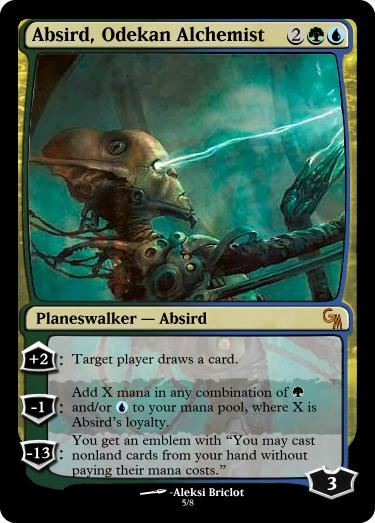
7th Place – Loki_thp
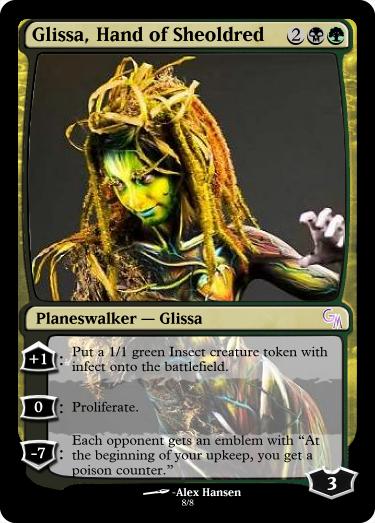
6th Place – AJK
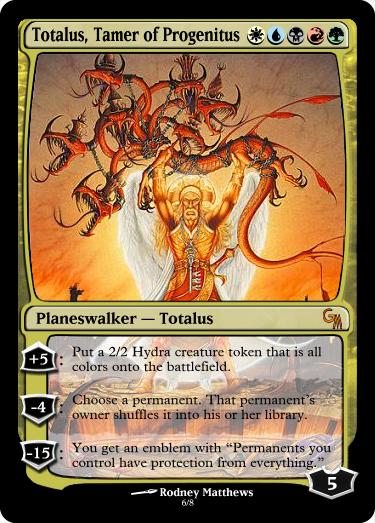
5th Place – Jeff Hansen
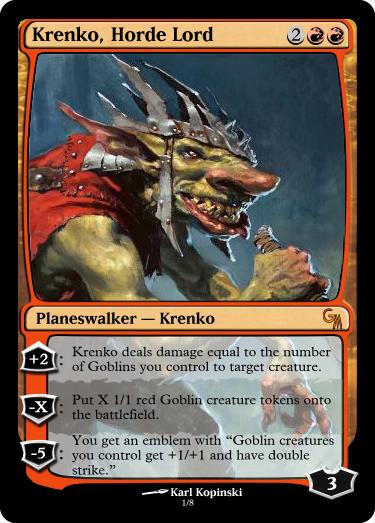
4th Place – Devin Green
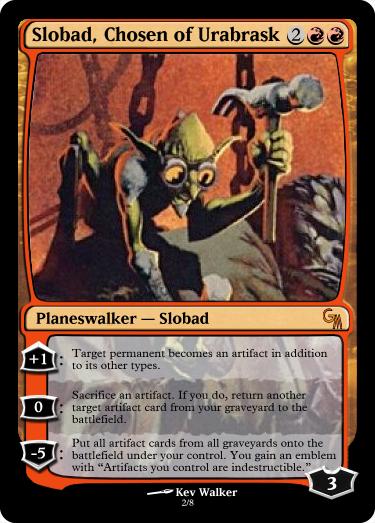
In the article that led to this contest, I talked an awful lot about making a planeswalker’s abilities play into one another. At first, these three may not seem to be exemplars of that philosophy, but I assure you they are. Don’t want to take my word for it? Luckily, Devin does an excellent job of addressing the issue in this card’s write up:
One thing Devin doesn’t mention is that this new Slobad also plays nicely with the Wild Guess effects that red’s recently added to its arsenal. So while he’s certainly not as open-ended as something like Chandra Nalaar, Slobad could find a home in a multitude of red decks if he were in Scars of Mirrodin block: an artifact reanimator deck, a midrange metalcraft deck, a deck full of Oxidda Scrapmelters, a control deck hoping to protect him until he creates an unbreachable wall, or some combination thereof.
It is unfortunate, as Devin notes, that Slobad wouldn’t be immediately appealing to the entire player base, but since that issue stems from effects that do weird things—rather than just normal things that look weak—I think the Johnny appeal could justify this type of card. On top of that, if you can convince players to pick up Slobad, the card gives players of all psychographic types the opportunity to feel what Johnnies and Goblin Artificers alike are always searching for: a point where all of their fiddling around finally comes together to do something incredible.
3rd Place – Alex Churchill
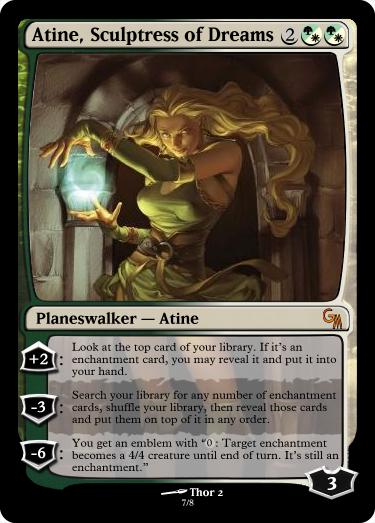
Atine’s abilities lead into one another in a much more straightforward manner. The middle ability can ensure that the +2 is going to hit for a long, long time, and both of the smaller abilities help you build up the critical mass of enchantments needed to make Atine’s ultimate lethal.
This synergy likewise gives playing with Atine the feel of searching for pieces of a puzzle and then crafting a plan to achieve some grand design. That’s rather appropriate given the character bio from his custom set that Alex was working from:
The green-white group of enchanters is perhaps the most unusual. A lot of the upper class are in this group: it's become fashionable to take a country stately home and grounds, and augment them massively with layer after layer of magical enhancements. These augmented mansions are called mirrorglades.
One particularly prominent mirrorglade is the Ralatine, in a forest near the city of Terina. Its owner is an arrogant duchess and enchantress named Atine, who's unusual in that she applies most of the augments to her mansion herself rather than hiring enchanters to do it for her. She's liberally enhanced every part of her home and its extensive grounds with magic, and is rather proud of her work. Designing enchantments is quite a prestigious role in this society, so although it's unusual for a noble to do it herself, it's certainly not looked down on.
But even a design this well thought out is not without its flaws. The first is Atine’s hybrid nature. The first ability could be justified by Verduran Enchantress and the like, and while Opalescence is a white card, I can see an argument for making the ability to give life to the inanimate universally green, but tutoring for enchantments like the −3 ability does is strictly in white’s slice of the color pie (yeah, yeah, black can tutor for anything). Thankfully, that’s pretty easily fixable—like this:
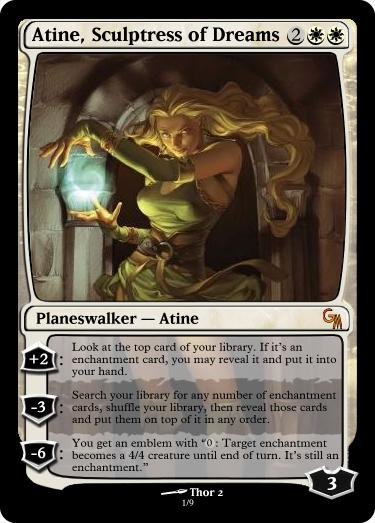
The bigger issue is the actual −3 ability. Yes, white can tutor for enchantments; yes, the ability plays very nicely with both of the others; and yes, it does feel like planning your estate. Those are all fantastic attributes, but they don’t justify the ability’s scope. Now, before you go off on me because I said I didn’t care if cards were under-costed, let me assure you that this is not an issue of costing. I wouldn’t accept this middle ability as the ultimate of a 7-mana planeswalker—not because it’s too strong, but because it’s not fun.
One player spends the rest of the game never being surprised by a draw, and his opponent sits there for ten minutes while he sets it up. That’s not exactly an appealing description if you ask me. Luckily, this issue too can be easily resolved; changing “any number of” to “up to four” means that every three turns, the player can use the ability to ensure that the next two activations of the +2 will hit, but Atine’s controller still receives an unknown draw and will spend much less time on the planning session.
These are exactly the sorts of reasons that cards are designed by teams rather than individuals. Coming up with a great concept is difficult, but it’s not the end of the road. Getting an extra set of eyes on your work will allow you to poke holes in your ideas and patch them up far more efficiently than attempting to do so by yourself.
2nd Place – Ryan and Jasna Kubin
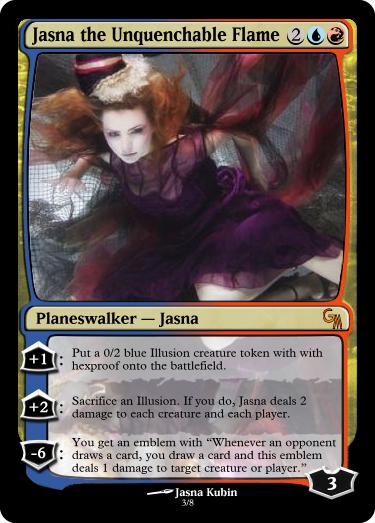
Moving on to our second-place finishers, we see a planeswalker that’s as much designed for Spikes as Slobad is for Johnnies. The fact that the tokens Jasna makes have hexproof allows for careful planning without the opportunity to be burned, and the first two abilities have obvious synergy in that using the first ability turns on the second. However, using the second ability, you give your opponent an easy out to the hexproof army you’ve been assembling, so as Jasna’s controller, you’re asked to carefully weigh the costs and benefits of using it. The card also offers an opportunity to make tough decisions about whether it’s worth losing a turn of activation to build up to the ultimate faster (using the +2 without an Illusion), and once you get there, the ultimate is the very definition of incremental advantage.
Liliana of the Veil is by far the most Spike-friendly planeswalker printed thus far, and Jasna’s approximately on par. Liliana had some wider appeal because it pleases the Griefer Timmy crowd as well, but the existence of mythics such as Molten-Tail Masticore would seem to suggest that there’s room for a Jasna in our future.
The one area that I’d love to see a change is in the ultimate. It does relate to the + abilities in that they both buy time and, given enough time, Jasna’s emblem will win the game, but it doesn’t feel as though it relates. I could easily see making an emblem that dealt damage scaling based on the number of Illusions you control or triggered whenever a creature was dealt damage, but ultimately, the psychographic this card is intended to please is the least likely group to care about that sort of thing, so I’d be okay reverting to this version if it had superior gameplay.
1st Place – Jay Treat
And finally, the crème de la crème:
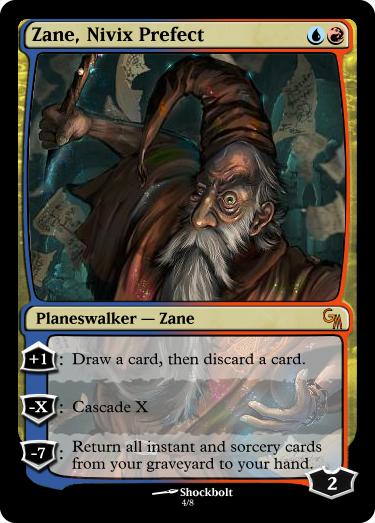
Jay’s a Great Designer Search 2 finalist, the lead designer on the Goblin Artisans M13 project, and a seasoned game designer, so it should surprise no one that he has the necessary chops to make something great, but let’s talk about what makes Zane awesome.
Synergy
The first and second abilities both stock your graveyard for Zane’s ultimate, and if you pull that off with the planeswalker in one piece, his +1 ability will even make use of any returned cards that aren’t applicable to the situation at hand.
But what exactly does “Cascade X” mean? It doesn’t say anywhere in the Comprehensive Rules, and Jay gave no explanation. Luckily, none is needed. While cascading involves a lot of numbers, the one that defines it is the converted mana cost of the cascade spell. Assuming the mechanic was used in Zane’s set (it’s a great fit for the Izzet), I think most players would immediately grok the new twist.
Brevity
Looking through these designs, or even printed planeswalkers, you may notice that things become awfully wordy. Jace, Memory Adept has forty-five words of rules text, a fairly standard count, whereas Zane is more than twice as succinct!
I know it’s easy to scoff at people who don’t want to read texty cards, but this isn’t just some vague sense that less is more. People have to do work to parse long rules text, and by association with this difficulty, text-heavy cards are simply less beloved than their pithy counterparts. It’s not the be-all-end-all of card design, but keeping things short is well worthwhile when it’s possible.
Character
What should an old Izzet mage feel like? Well, he does a lot of research, though perhaps not in the most controlled environment imaginable. You know, he might just try things out and throw some away, do something unpredictable and run with the result, or rifle through notes and elixirs looking for whatever fits his present purpose. The first two abilities capture this mindset perfectly.
And what of the third? Why, crazy old Zane just picked up all of his findings, and he’s about to combine them in whatever manner strikes his fancy. I’ve been back home visiting family, and while I was looking over the submissions for this contest, my brother mentioned that Zane’s ultimate ought to give the player a Spellbook emblem like Tamiyo, the Moon Sage's does. At first, I thought Jay had left that out just to keep things brief, but thinking about it, I realized that this was actually a flavor choice. The mad scientist hasn’t organized a notebook to keep careful track of all his findings; he’s picked up more than he can hold, and he’s bound to drop some of it.
Finishing Up
I hope you enjoyed this planeswalker-making contest, and if you didn’t participate, I’d encourage you to do so next time I run something like this. Not only is it a lot of fun, digging in and doing some design is the best way to improve. I’ll also reiterate: If you did make a submission and want more feedback, just shoot me a follow-up e-mail, and I’ll get back to you as soon as I find the time.
By the time this article goes up, I’ll already be in New York, so I’m not sure if I’ll be able to have the wrap up for my Magic 2013 Design Review ready next week, but if not, you can expect it the following week. After that, you may not hear from me for a few weeks, as I’ll be touring Costa Rica before the Grand Prix. If you’re going, feel free to hit me up via e-mail or Twitter, and if not, you can still expect some news from San Jose when I get back.
Finally, I want to ask a question before you go:
[poll id=196]
























